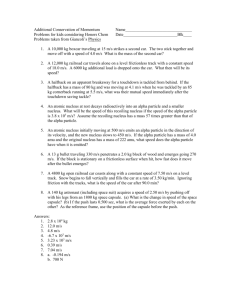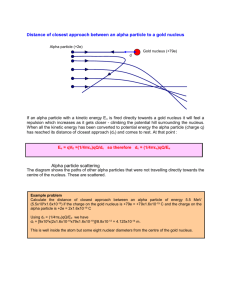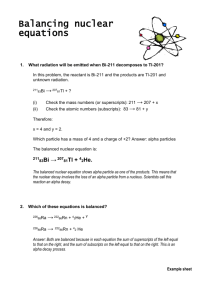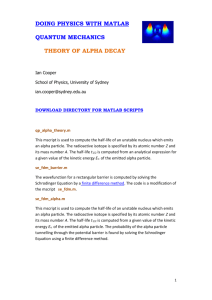Lecture 36
advertisement
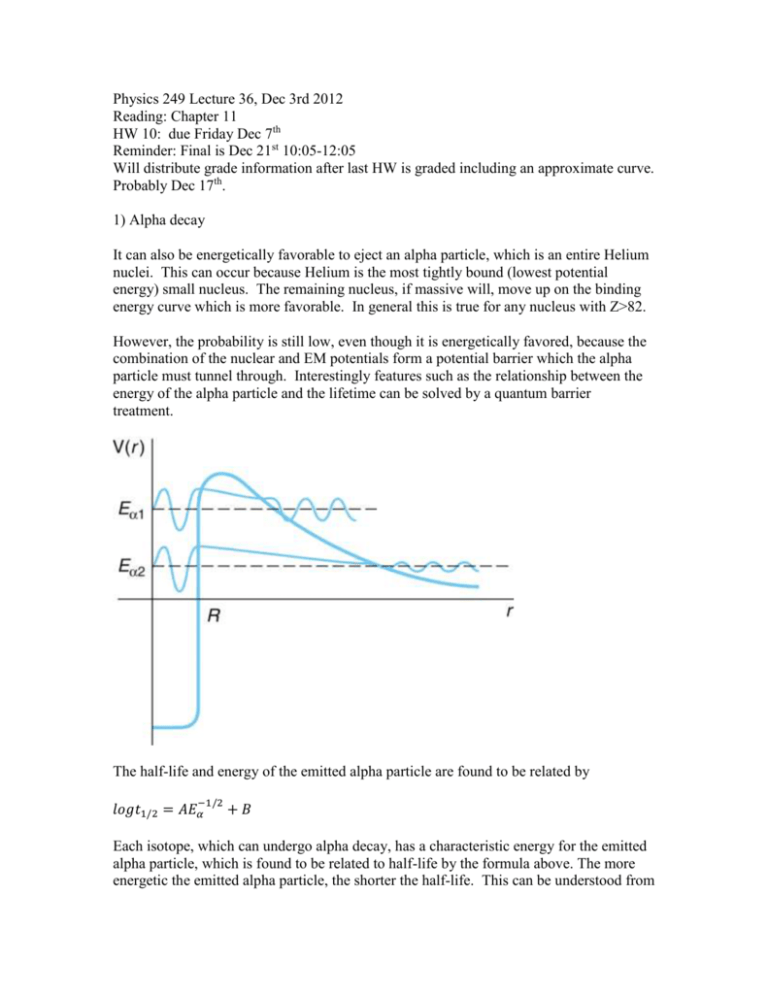
Physics 249 Lecture 36, Dec 3rd 2012 Reading: Chapter 11 HW 10: due Friday Dec 7th Reminder: Final is Dec 21st 10:05-12:05 Will distribute grade information after last HW is graded including an approximate curve. Probably Dec 17th. 1) Alpha decay It can also be energetically favorable to eject an alpha particle, which is an entire Helium nuclei. This can occur because Helium is the most tightly bound (lowest potential energy) small nucleus. The remaining nucleus, if massive will, move up on the binding energy curve which is more favorable. In general this is true for any nucleus with Z>82. However, the probability is still low, even though it is energetically favored, because the combination of the nuclear and EM potentials form a potential barrier which the alpha particle must tunnel through. Interestingly features such as the relationship between the energy of the alpha particle and the lifetime can be solved by a quantum barrier treatment. The half-life and energy of the emitted alpha particle are found to be related by −1/2 𝑙𝑜𝑔𝑡1/2 = 𝐴𝐸𝛼 +𝐵 Each isotope, which can undergo alpha decay, has a characteristic energy for the emitted alpha particle, which is found to be related to half-life by the formula above. The more energetic the emitted alpha particle, the shorter the half-life. This can be understood from the concepts of tunneling from a potential well. The higher the energy of the particle trapped in the potential well the more probable it is that it can tunnel out of the system. The relationship can be derived more exactly by calculating the transmission probability out of a potential well that is composed of the strong potential square well inside the nucleus and 1/r coulomb term outside the nucleus. −1/2 𝑙𝑜𝑔𝑡1/2 = 1.61(𝑍𝐸𝛼 − 𝑍 2/3 ) − 28.9 The exact relationship is found to depend on Z. However, since the range Z for atoms where alpha decay occurs is fairly limited this reduces approximately to the form that was first observed above. The heavy nuclei Z>82 are unstable to alpha decay since the mass of the initial state nucleus is larger than that of the final state nucleus and alpha particle. This formula relates the energy of the observed alpha particle to the half-life. It is difficult to predict the hypothetical kinetic energy of the alpha particle inside the nucleus. Though based on the shell model you would expect nuclei with similarly filled shells in terms of protons and neutron to decay in similar ways. Note that you can have a chains of alpha particle emissions since as long as Z>82 it is possible to emit another alpha particle. Note that alpha decay and fission into larger atoms is just a more complex extension of this idea the same process that results in proton and neutron emission. Alpha decay and fission dominate for larger atoms especially above the 126 magic number, which ends one of the largest shells, and above which adding any protons or neutrons tends to be unstable. 3) Types of decay that transmute atoms. The above types of decays all transmute the atoms changing their Z and allowing unstable nuclei to become (more) stable nuclei or stable pairs of nuclei. The decay patterns of the radioactive isotopes within the valley of stability have been mapped out as shown in the figure below. 3) Gamma decay A nucleus can decay from an excited state to a lower energy state by emission of a gamma ray. The gamma ray will have almost exactly the energy of the change in energy state. Not exactly because energy and momentum must be conserved. The nuclease will recoil with equal and opposite momentum and very low velocity and energy. The velocity is low enough that we can calculate the energy classically. 𝑝𝑁 = 𝑚𝑣 = 𝑝𝛾 = ℏ𝜔, where 𝜔 is the angular frequency of the photon. 𝐸𝑁 = (ℏ𝜔)2 𝑝2 = ≪ 𝐸𝛾 = ℏ𝜔 2𝑀 2𝑀 4) Fusion Most of the processes we have been considering tend to either not change the A of the nuclei or reduce them. For light nuclei there are energetically favorable interactions that move in the opposite direction. The series of interactions that occurs in the sun to produce energy is 1 𝐻 + 1𝐻 → 2𝐻 + 𝑒 + + 𝜈𝑒 note the positron will annihilate immediately with an electron producing more energy in the form of a photon while the neutrino energy is essentially lost. (keep this in mind in the homework) 𝐻 + 1𝐻 → 3𝐻𝑒 + 𝛾 2 3 𝐻𝑒 + 3𝐻𝑒 → 4𝐻𝑒 + 2 1𝐻 + 𝛾 The total of this process emits ~20MeV of energy.

